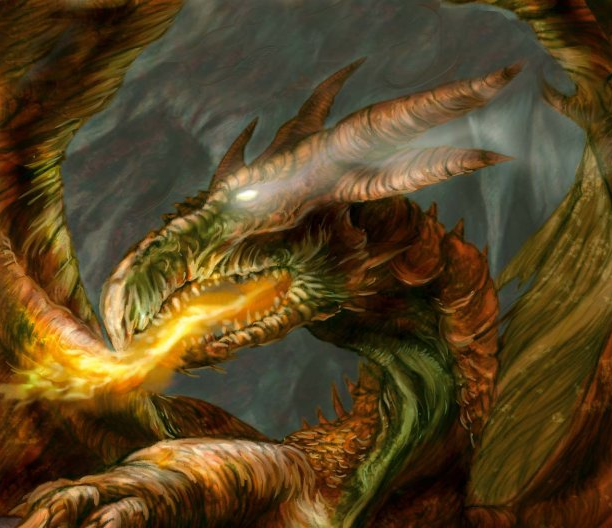 Creepy
Creepy  Creepy
Creepy  Technology
Technology 10 Scientific Breakthroughs of 2025 That’ll Change Everything
 Our World
Our World 10 Ways Icelandic Culture Makes Other Countries Look Boring
 Misconceptions
Misconceptions 10 Common Misconceptions About the Victorian Era
 Mysteries
Mysteries 10 Strange Unexplained Mysteries of 2025
 Miscellaneous
Miscellaneous 10 of History’s Most Bell-Ringing Finishing Moves
 History
History 10 Great Escapes That Ended Right Back in Captivity
 Weird Stuff
Weird Stuff 10 Fascinating Things You Might Not Know About Spiders
 Food
Food 10 Everyday Foods You Didn’t Know Were Invented by the U.S. Military
 History
History 10 Odd Things Colonial Americans Kept at Home
 Creepy
Creepy 10 More Representations of Death from Myth, Legend, and Folktale
 Technology
Technology 10 Scientific Breakthroughs of 2025 That’ll Change Everything
 Our World
Our World 10 Ways Icelandic Culture Makes Other Countries Look Boring
Who's Behind Listverse?

Jamie Frater
Head Editor
Jamie founded Listverse due to an insatiable desire to share fascinating, obscure, and bizarre facts. He has been a guest speaker on numerous national radio and television stations and is a five time published author.
More About Us Misconceptions
Misconceptions 10 Common Misconceptions About the Victorian Era
 Mysteries
Mysteries 10 Strange Unexplained Mysteries of 2025
 Miscellaneous
Miscellaneous 10 of History’s Most Bell-Ringing Finishing Moves
 History
History 10 Great Escapes That Ended Right Back in Captivity
 Weird Stuff
Weird Stuff 10 Fascinating Things You Might Not Know About Spiders
 Food
Food 10 Everyday Foods You Didn’t Know Were Invented by the U.S. Military
 History
History 10 Odd Things Colonial Americans Kept at Home
10 Lesser-Known Dragon Slayings From Legend
This list contains ten lesser-known tales of dragon-slaying from around the world. A great number of these took place in Europe—most likely because dragons there have long been considered a force of evil, whereas in the East they are often seen as symbols of goodness and prosperity.
There may well be some awesome tales that didn’t make it into this list (any tale with a dragon in it is awesome, after all)—so please let us know in the comments.
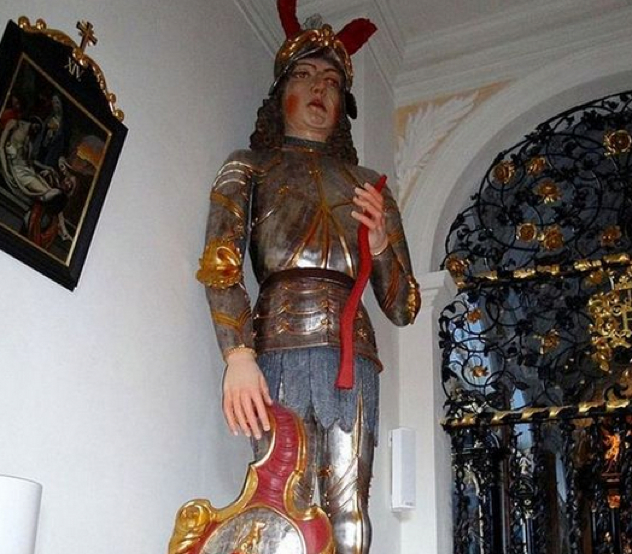
It most often requires great cunning to defeat a dragon, and that’s the virtue which crops up again and again in stories about dragon slayers. We start the list, however, with a case of brute strength being the victor.
An unnamed dragon is said to have terrorized the area around the Austrian city of Innsbruck. It hoarded a massive treasure of gold, small pieces of which occasionally got swept away by the local river and found by villagers. Whenever the dragon noticed a loss of coin, it would devastate the surrounding countryside, smashing houses and killing locals in a fury of revenge.
Thankfully, a giant by the name of Haymo happened to live nearby. He was twelve feet tall, and of noble heritage. His strength was unmatched—and he believed that he could stand up to the dragon. So the giant put on his suit of armor, and marched with grim determination through the piles of rubble the dragon had created from what had been whole villages. Finding the dragon just as it was getting ready for another rampage, Haymo jumped onto it and began pounding it with his fists. The dragon writhed and squealed in pain, eventually breaking free and fleeing to its cave. Haymo followed it, ultimately stabbing it and cutting out its tongue, which he presented to the locals as proof that they no longer had to fear the terrible dragon.
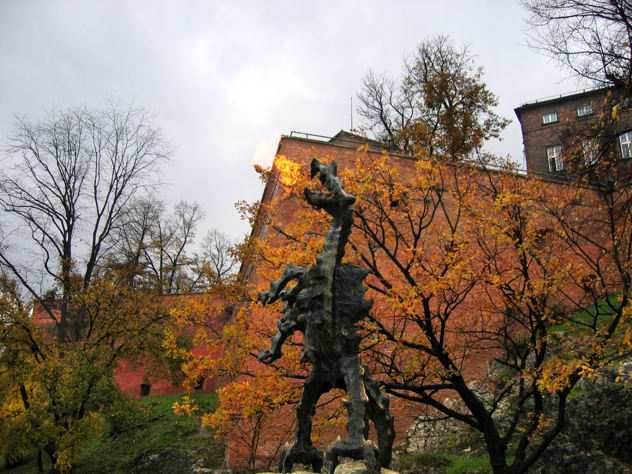
Krakow, the ancient capital of Poland, is said to have been founded above the lair of a dragon known locally as Smok Wawelski. There are a number of versions of this tale, but the most popular has it that the dragon pillaged the countryside for many years, devouring livestock and terrifying farmers. The king sent out a call to noblemen and knights throughout the land, stating that whoever managed to slay the dragon would be rewarded with riches and marriage to his daughter. But none of the knights were able to get the better of the dragon, who quickly reduced all comers to a pile of ash.
A poor shoemaker’s apprentice named Skuba eventually volunteered his assistance. The king, who was by this stage rather desperate, agreed—though few people had much faith in the ability of the young lad. Skuba knew that he couldn’t kill the dragon with force, so he set a trap.
He killed three lambs, stuffed them with spices and sulphur, and left them lying outside the dragon’s cave. After the dragon had devoured this tasty morsel, he experienced a massive burning in his stomach. The pain became so great that he drank half of the nearby river in an attempt to quench it—eventually consuming so much water that he actually exploded.
Should you ever find yourself in Poland, you can still visit the dragon’s cave today.
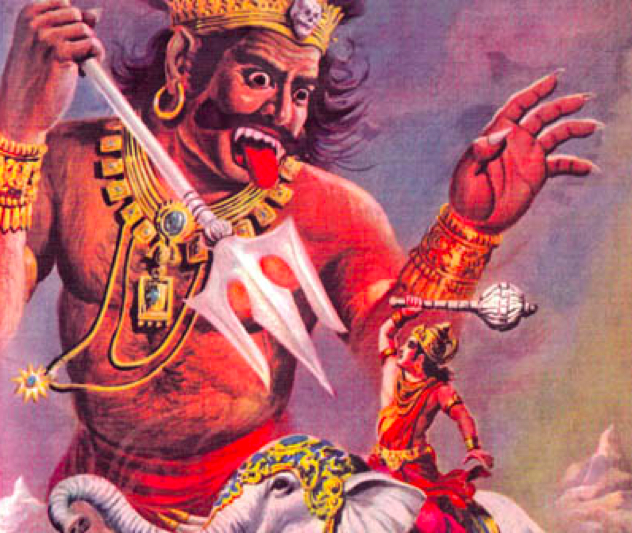
According to various pre-Hindu religions, the asuras were a type of demigod or demon (direct translation is difficult as the pantheon is different to those familiar in the West). The most powerful of these demigods was Vritra, a dragon so big that his body covered the whole world. He would sometimes use his coils to block rivers, earning him the nickname “bringer of drought.” He eventually had the nerve to steal Earth’s entire supply of water, turning the planet into a desolate wasteland.
Vritra was slain by Indra, who would later go on to become king of the gods. Shortly after Indra was born, he set out and managed to demolish ninety-nine fortresses belonging to Vritra. Inevitably, a huge battle ensued. Indra was ultimately victorious, and “with his own great and deadly thunder smote [Vritra] into pieces,” thereby freeing the waters of the world.
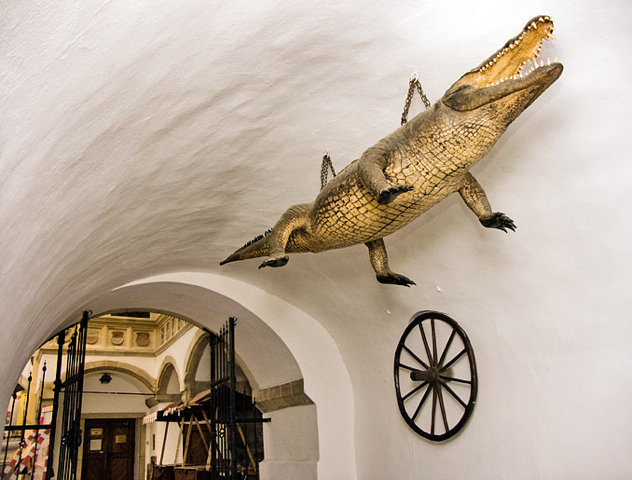
The story of the Brno dragon is similar to that of the Wawel dragon above, except that this dragon is actually a crocodile. Yet its nickname—the “Brno dragon”—and its present-day resting place, hung by chains from the ceiling of the Town Hall, justify its place on this list.
Legend has it that near the beginning of the last millennium, the people of Brno were tormented by this beast, who lived in a cave and would eat anything that came his way. The frightened townspeople didn’t know how to deal with the problem, but they were luckily soon visited by a traveling butcher.
The cunning butcher, hoping to slay the beast, sewed a bunch of quicklime into an ox-pelt and left it out to be eaten. The dragon duly gobbled it up. Quicklime reacts rather vigorously with water—so when the beast washed its meal down with large swigs from the river, the contents of its stomach began to boil. The crocodile burst open, much to the delight of the locals, who sewed him back up and had him mounted on the ceiling for prosperity. The butcher earned a reward of one hundred gold coins, and presumably several xp into the bargain.
In Norse mythology, the dwarf Fafnir was one of three brothers. He didn’t begin life as a dragon, but became one after murdering his father for gold. He hid in the wilderness with the treasure, and became a dragon in order to better guard it. Unfortunately for the upstart dragon, he also happened to breathe poison around the land, which the locals understandably weren’t too happy about.
Fafnir’s brother, the blacksmith Regin, asked his own step-son—the young hero Sigurd—to kill the problematic dragon. Sigurd decided to dig a ditch, hiding there with the aim of suddenly leaping out and stabbing Fafnir in the heart.
Odin, King of the Gods, for his own reasons turned up and advised Sigurd to dig a number of other ditches to drain away the dragon’s blood, so that he wouldn’t drown. Sigurd listened to the advice, and when Fafnir showed up he duly attacked him. Though he missed the heart (instead plunging his sword into the dragon’s shoulder), the wound still turned out to be fatal.
Regin then asked Sigurd to cook the dragon’s heart. Sigurd, for some reason seeing nothing odd about this, did as he was told. He touched the heart to check if it was cooked, and burned his thumb in the process; and when he touched his thumb to his mouth in order to ease the pain, he suddenly found that he was able to understand the speech of birds. These birds told Sigurd that Regin intended to kill him, so the young hero killed Regin first, and made off with all of the gold himself.
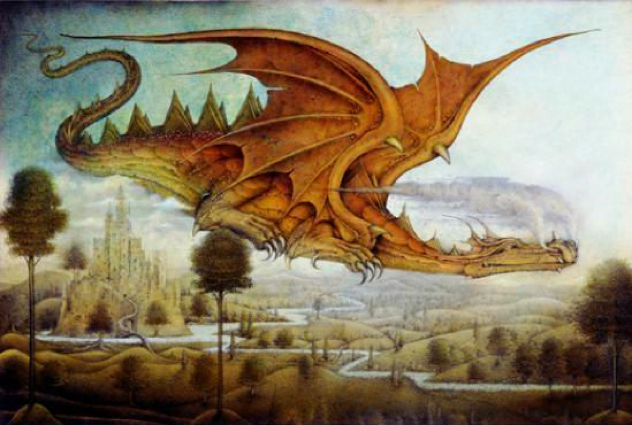
The story of the dragon of Modiford starts out with a little girl named Maud. She was walking in the woods one day when she found a bright green baby dragon, smaller than a cucumber. She took it home with her and fed it milk, but as it grew in size, it began to consume chickens and other small animals. When it reached adulthood, it took to eating people—though throughout this process it remained friendly to Maud.
In what seems to be a recurring theme, the people living in the area weren’t too keen on having a man-eating beast in their midst—but they were at a loss as to how they might get rid of it.
There are a number of stories about how the dragon was killed. Most of them involve a convicted criminal who was offered pardon in exchange for slaying the beast. According to one story, he hid in a cider barrel and shot the dragon when it approached. Another story has it that he rigged the barrel with spikes and hooks, and the dragon impaled itself when it attempted to wrap itself around him. Two more stories involve the dragon being ambushed in its sleep—in one instance by the above criminal, and in another instance by a rabble of pitchfork-wielding villagers.
Perhaps the people of Modiford celebrated the dragon’s death a little too enthusiastically, and the details became blurry? We can probably forgive them for that.
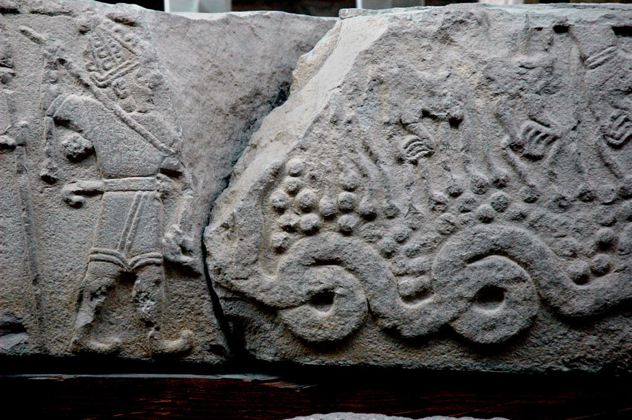
There are two versions of the battle of the Hittite Storm God with the dragon-like giant Illuyanka. I will recount my favorite one here, but you can read them both here if you wish. Sadly, we know very little about the details of Hittite mythology, so the story has a few gaps in it (we aren’t told, for example, why the Storm God and the dragon didn’t get along).
During their first battle, Illuyanka the dragon was victorious over the Storm God. The despondent Storm God went to see the Mother God, Inata, to ask for her help in getting revenge. Inata came up with a plan, but she needed some assistance to carry it out—and for this, she went to a human man called Huspashiya. Huspashiya agreed to assist the god in return for letting him sleep with her, which she duly did. They then put together a large feast, with quite a significant amount of alcohol, and invited the serpent Illuyanka and all of his family to have his fill. When he was too drunk to move, they proceeded to tie up the serpent and the rest of his family up, allowing the Storm God to come and finish him off.
Huspashiya’s fate wasn’t much better, either. He went to live with his newfound goddess-lover, but was forbidden from looking out of the window. After twenty days of resisting the temptation to do so, he finally couldn’t help himself—and when he looked out, he saw his wife and child. He begged to be allowed to return to them, and . . . that’s all we know for certain, as the original source of the story is damaged from that point onwards. Scholars suspect that he was either killed for disobeying, or granted his wish after being castrated.
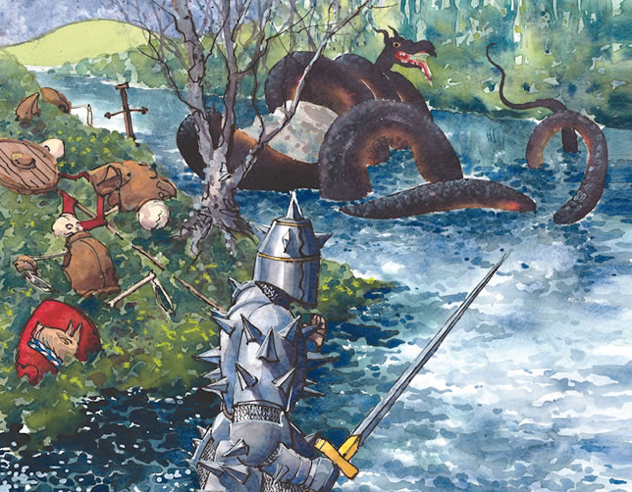
The story of the Lambton worm begins in the thirteenth century with a rebellious young boy named John Lambton, the son of a local lord in Durham Country, England. One Sunday, John decided to skip church, instead deciding to go fishing. Despite being warned that skipping church would bring no good, John set himself up for some relaxed angling. After a couple of hours, he caught a small, black, worm-like creature, which had the features of a salamander. Thinking it strange but of little further interest, he threw it into a well and got on with his life.
In adulthood, John joined the crusades as atonement for his youthful transgressions. While he was gone, the worm—by now fully grown—had emerged from the well. It wrapped itself seven times around a local hill, terrorizing villagers by eating their livestock and even snatching small children. The elderly Lord Lambton was able to sedate the worm by offering it twenty gallons of milk a day—but the local impact of the worm’s presence was devastating.
Upon his return from the crusades, John Lambton learned of the giant worm. Many had already tried to slay the beast, but whenever a piece of it was cut away it would simply reattach and heal itself. John sought the advice of a local witch, who advised him to attach spear-points to his armor and to fight the worm in the local river. He did so—and when the worm tried to wrap itself around him, its flesh was torn by the spear points, and the mangled pieces were washed away by the river’s current.
John was able to vanquish the beast, but in doing so he incurred a curse against his family which would last for nine generations: not a single of his descendants was to die peacefully in bed, as long as the curse lasted.
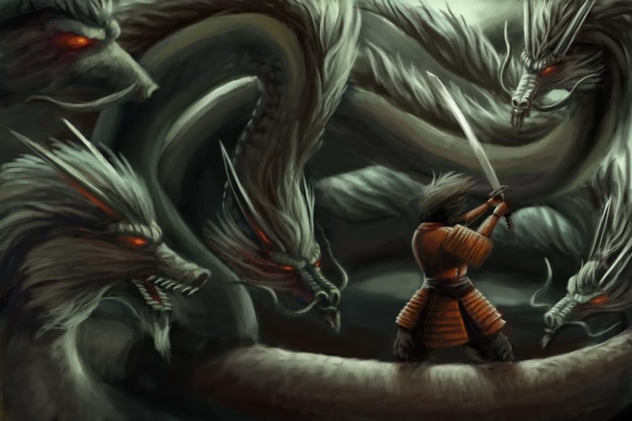
While walking along the river one day, the Shinto storm god Susanoo came across an old couple and their daughter, a young girl. Noticing that both of the couple were in tears, Susanoo enquired as to the cause of their troubles. They explained that they had once had eight daughters, but in each of the last seven years the giant serpent Orochi had eaten one daughter—and was now due to return for their last.
The old man explained that the beast had eight heads, eight tails, and a body the length of eight valleys. If there’s one thing this list has taught us, it’s that the best way for a storm god to slay a dragon is to get it drunk. Susanoo advised the old couple to build a fence with eight gates, and behind each gate to place a bucket of refined liquor. They duly did so, and when the beast arrived, each of its heads gulped down the contents of the buckets, which resulted in the dragon becoming intoxicated. Susanoo proceeded to hack the beast into pieces, turning the River Hi into a river of blood.

This is the only African tale on this list, taking place in what is modern-day Ghana. In the town of Wagadu, in ancient times, the people had made a deal with a dragon called Bida. They fed the dragon ten young maidens each year, and in return Bida made it rain gold three times annually. The town chief Lagarre, grandson of the chief that had originally made the deal, was able to renegotiate this to just one maiden a year in return for the same three rainfalls of gold. Eventually, it became the turn of the most beautiful maiden in the kingdom, Sia Jatta Bari, to be fed to the beast. She was dressed in wedding garb, and led out to the dragon’s lair.
Sia’s lover, Mamadi Sefe Dekote, had other ideas. He rode dutifully with the procession, but secretly harbored a plan of his own. He knew that it was the dragon’s custom to stick its head out of his cave three times, before snatching its meal on the third. As Bida’s head came out for the final time, Mamadi struck the dragon, killing it, and saving Sia. Celebrations all round, right?
Not quite. It turned out that the people had become quite used to the rainfall of gold provided by Bida—so they chased both Mamadi and Sia out of Wagadu. Also, it seems that Sia didn’t love Mamadi quite as much as he loved her, and tricked him into cutting off a finger and a toe. She then declared that she couldn’t love anyone who didn’t possess a full compliment of digits.
Mamadi was understandably upset by this point. He presumably reminded Sia that he’d killed a dragon for her, but ultimately turned to a witch for a love potion, which made Sia fall instantly in love with him. Mamadi then tricked Sia into sleeping with one of his servants—and when she realized what she’d done, she died instantly of pure shame.
Alan is an aspiring writer trying to kick-start his career with an awesome beard and an addiction to coffee. You can hear his bad jokes by reading them aloud to yourself from Twitter where he is @SkepticalNumber or you can email him at [email protected].
